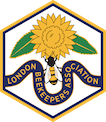
|
London Beekeepers' Association |

|
London Beekeepers' Association |
Packaging and labelling honeyby David Hankins and first published in the October 2016 edition of LBKA's newsletter.For beekeepers in England, the rules relating to honey labelling have been amended, revoked and amended again a number of times over the last couple of decades. Most of the current rules are to be found in The Honey (England) Regulations 2015". What follows is a simplified guide to those regulations, applicable to the semi-commercial or hobby beekeeper wishing to sell his/her honey locally. This guidance is designed only for the labelling of honey produced by the beekeeper's own bees, and harvested and packaged by the beekeeper - it does not cover honey of uncertain provenance, or with known additives to the natural product. The label must contain the word "honey"This may be prefixed with additional wording to give what is termed the "reserved description" or "type" of honey, as follows: Baker's Honey; Blossom Honey; Chunk Honey; Comb Honey; Cut Comb in Honey; Drained Honey; Extracted Honey; Filtered Honey; Honeydew Honey; Nectar Honey; Pressed Honey. Additional descriptive or clarifying words may also be used, providing they do not mislead. Examples might include "Natural Honey", "Pure Honey", "Hedgerow Honey" and "Wildflower Honey". If referencing particular plants or blossom, as in "Sweet Chestnut Honey", "White Clover Honey" or "Oilseed Rape Honey", the product must come wholly or mainly, (more than 75%), from that blossom or plant. The label on Baker's Honey should also contain the words "intended for cooking only". The label must contain the name and address of the producer/beekeeperThis is so that you can be traced in the event of a problem with the product you have sold. Looked at another way, it's also potentially a great tool for generating repeat business, so you might as well add your telephone number! The label must state the country of origin"Produce of England", "Produced in England" and "Harvested in England" would all be appropriate. Reference may also be made to a smaller geographic area, such as "Kent", "London" or "Camden", but if such a reference is made, the honey must come wholly from that place - a Trading Standards Inspector may frown on Haringey nectar found in Hackney honey, so use care if describing the geographic origin of your honey. The label must have a "best before" dateThis date needs to consist of at least a month and year, such as "Best before end September 2018", but what date should you chose? The best advice I found was "Two years from the date of bottling is reasonable". Other advice suggests "A Best Before date is usually between two and five years". There is no rule, and we all know that honey harvested carefully and stored well will keep for a lot longer than other foods, but to err on the side of caution is probably wise. (If anyone can find better guidance on this point, please let us all know.) The label must state the net weight of the productThis is the weight of honey, without packaging, in metric. To be certain of this net weight, weigh a sample jar, (or other form of packaging you use), before and after filling, and subtract the empty weight from the full weight. And remember, jars sold for different fillings but quoting the same weight may well have different volumes, so check the net weight with the method described above before printing the weight on the label. The label should have a "lot" markThis is to enable the product to be traced to an individual "batch" of honey, which is useful if batches were jarred at different times or sourced from different apiaries. For a small scale producer with a single apiary and harvest per year, and all produce jarred or otherwise packaged at the same time, the "best before" date with day, month and year may suffice - but a "lot" number on your labels may do no harm to people's perception of you as a supplier! Other thingsThat's all the items that either must or should be on a honey label, but there are a few other things worth mentioning. Firstly, under a voluntary scheme, all honey sold through large retailers includes a warning statement that honey is "unsuitable for children under 12 months". This is a precautionary measure against possible infant botulism, which could potentially arise from the presence of Clostridium botulinum spores in honey. Secondly, the labelling of honey as being "organic" may not always be advisable, given the lack of control beekeepers have over the foraging of their bees. There are detailed standards to be applied to the production of a food in order that it can be called organic, and we have no idea whether our bees are meeting those standards when foraging on someone else's allotment or on the other side of the tracks - just a thought. The above is not a comprehensive guide to the regulations, but I hope it covers all the necessary points and offers just enough advice to be of interest, if not actually useful. If anyone spots any omissions or inaccuracies, please let me know - who knows how long I may have been "doing it wrong". |
©2024 London Beekeepers' Association |